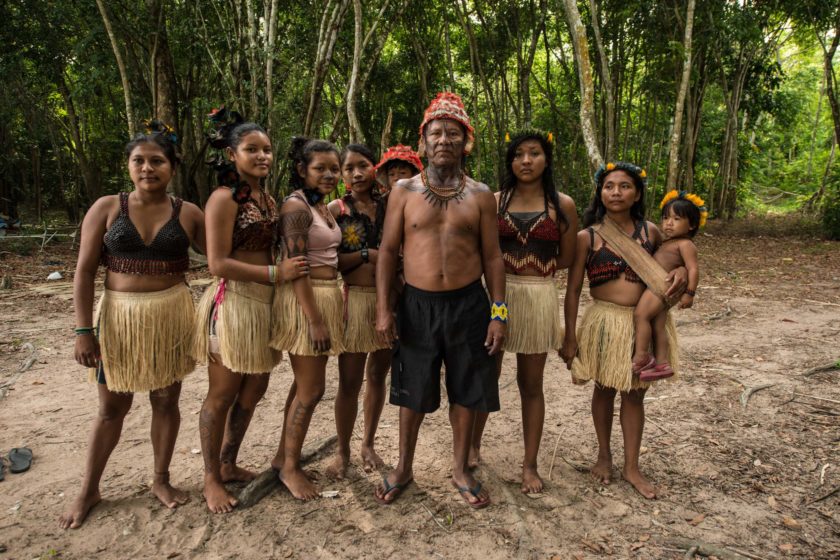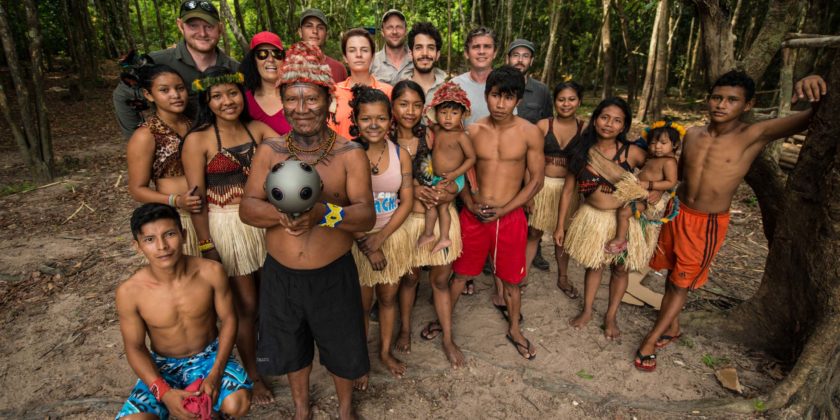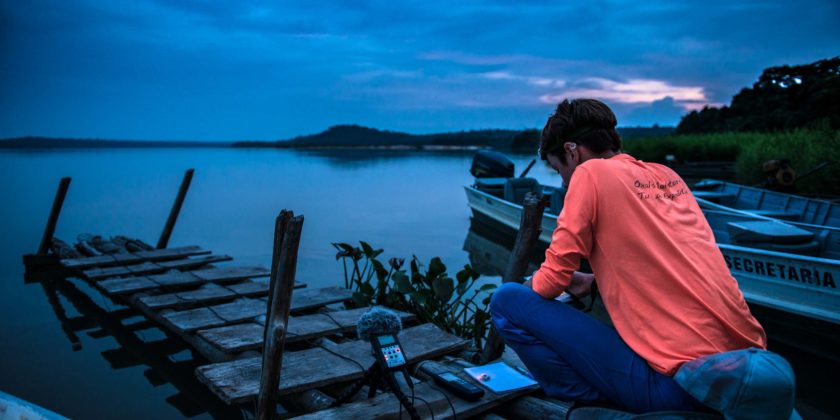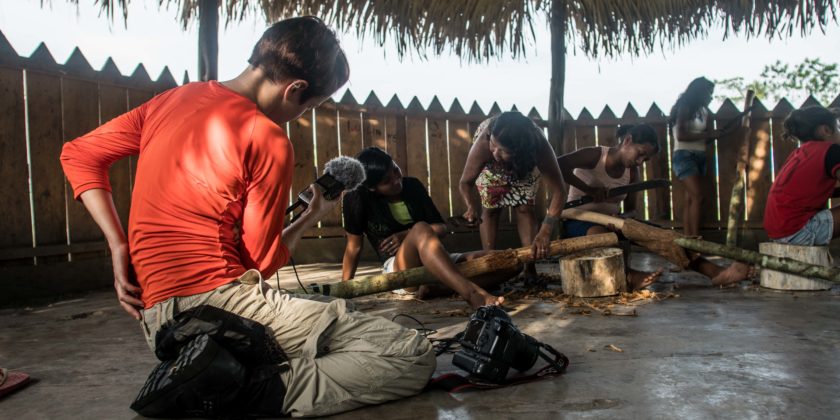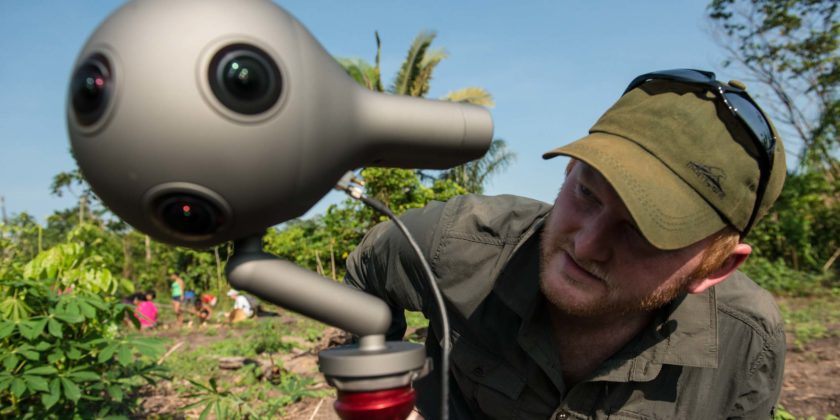USING YOUR SENSES IN VIRTUAL REALITY WITH THE FEELIES
“Humans are sensory beings, constantly taking in information through all our senses, so there are huge opportunities to reach people emotionally and effectively by communicating with more of their sensory modalities.”
– Grace Boyle, Director, The Feelies
Munduruku: The Fight to Defend the Heart of the Amazon is a multisensory VR-led experience created by The Feelies, Alchemy VR and Greenpeace. It takes the concept of immersive projects to a new level by combining a 360 VR film and binaural sound with additional sensory triggers, including scents, vibrations, humidity, touch and temperature changes.
Why was the project developed?
“The purpose of this project is to try to remove the invisibility of Indigenous People that is brought by large industrial projects such as hydroelectric dam building. The message we want to leave people with, that we want them to tell after seeing this film, is that the Munduruku have the right to exist here, with their river according to their culture and their way of life”
– Pete Speller, Greenpeace
The project was developed part of a broader campaign to raise awareness of the pressure facing the Munduruku, an Indigenous People living deep in the Amazon Forest of Brazil. Their lands in the Tapajós River basin are threatened by large-scale industrial projects, such as the development of huge hydroelectric dams that would flood huge areas of land, including several Munduruku villages and other riverside communities. These dams also create shipping channels in the shallow parts of the Tapajós River, allowing industrial-scale farming and logging to expand further into previously hard-to-reach parts of the Amazon rainforest.
Taking campaigning to a new level
“The installation transports viewers deep into one of the most remote areas of the Amazon, somewhere they would never ordinarily be able to visit. VR is the perfect tool for allowing viewers to experience first-hand the life of the Munduruku people and gain a true understanding of the challenges they face.”
– Anthony Geffen; CEO and founder, Alchemy VR
Greenpeace has a long history of successful environmental campaigning and connecting effectively with its supporters, and beyond, through impactful storytelling is an effective means of evoking empathy and, in turn, provoking action.
Harnessing the power of storytelling and combining it with immersive technology is a potential game changer for campaigning organisations. Virtual reality offers participants the chance to transport themselves into the story, but does it truly immerse participants in the environment?
By developing it from a VR project to a multisensory experience, participants don’t just see and hear the rainforest, but get a greater immersive experience by feeling the atmosphere, smelling different scents and sensing the rhythm of the forest.
“The Amazon is a formidable ecosystem, with a beauty and complexity that we hope to bring to city audiences by using scent, vibration and atmospheric changes in combination with the beautiful 360 video footage, to allow audiences to really connect with the Munduruku and the forests in which they live.”
– Grace Boyle
Importance of the authenticity of the narrative
As a piece grounded in environmental campaigning, a strong narrative was crucial to tell the story in order to effectively connect with audiences. The story was developed in collaboration with the Munduruku people, based around the concept of beauty turning into destruction. Having an initial focus on everyday life in this community, the story shifts with the introduction of lorries that bring industrialisation and the loss of lands to the remote forest setting.
The team were mindful of the trust the Munduruku had extended to them throughout the production, and is clear that the community had to be represented in a way that was authentic at all times. “The Munduruku were actually the ones who initially reached out to Greenpeace, a number of years before this project. They’re media-savvy and they knew that to protect their land, they had to make their voices heard” explains Grace. “Being able to build on that relationship of trust that has developed between Greenpeace Brazil and the Munduruku was so important, so that the story was reflected truthfully at all times. James Manisty, the VR director, conducted hours of interviews with different Munduruku Caciques (leaders) and that formed the basis of the script, which Cacique Juarez, who narrates the story, then reviewed and approved.” As such, the Munduruku weren’t just the subject of the experience, they were collaborators on the project, with their active input and influence on the narrative through interviews and sharing their way of life with the production team.
The project was conceived and developed to be a multisensory piece, so AlchemyVR and The Feelies worked together to deliberately place the order, subject and elements of some scenes to make the narrative comprehensive from a multi-sensory angle, as well as from a visual one. For any given moment in the experience, all the sensory stimuli have been placed to give the visitor coherent, emotional messages about the story they’re witnessing. Breaking from a more traditional script, The Feelies then developed a time-coded, multisensory script, based around an emotional narrative curve of the entire experience.
“For every sensory stimulus you put on a guest, there has to be a reason why,” says Grace. “What message is it giving them? What other stimuli are they taking in at the same time? Where does it take them emotionally?”
Journeying to the Amazon on a multisensory mission
The team then travelled to the Munduruku’s home to stay as their guests, and shoot for the experience. While AlchemyVR filmed the 360 footage and recorded binaural audio, The Feelies undertook a sensory mapping of the area; researching, collecting and recording sensory data that could then be transferred into the final piece.
The environment proved to be extremely complex, changing significantly depending on location and on the time of day, which significantly influenced the multisensory script. In addition to the process of scientifically mapping the environment, in-depth interviews with members of the Munduruku around their sensory knowledge of the forest also fed into the final experience. “The idea of how to perform a ‘sensory shoot’ is a fascinating one, and we’ve been working to develop that,” says Grace. “For the Munduruku, the forest is of course a fully sensory environment that they’re intimately acquainted with, so to be able to work with them as they shared some of that knowledge was a huge honour.”
Sounds and vibrations
Binaural sound was recorded, but this was also accompanied by a low frequency, infrasonic track, captured by recordings made in the forest and then woven into a final vibration track by sound artist Antoine Bertin in Paris. This introduced subtle vibration and sound cues to support the story’s narrative, including underwater hydrophone recordings of the river. Additionally, more unnatural vibrations, such as those of loud, juddering engines were included, which, in the finished product, moved the feel of the environment to a more unpleasant place for the parts in which the visitor witnesses the potential industrialisation and destruction of the forest. The infrasonic track was delivered through the SubPac, with adjustments to the audio so that the visitor only feels vibrations when it makes sense for them to embody the sound. It was also used creatively, for example to direct the visitor’s viewpoint in the 360 space, by playing them patterns of movements that they could see far off, but not hear.
Scents and atmosphere
A smell can conjure up memories and emotion in such a powerful way that it can transport us to other places and times, so bringing scents into a VR experience is a natural step to increasing the sense of place.
Capturing the differing scents was essential to help transporting participants into the heart of the forest. Perfumer Nadjib Achaibou, was part of The Feelies’ crew on the shoot in Brazil, with the mission to research the scents of the forest and Munduruku life, to create bespoke scents back in the UK for the olfactory parts of the story.
Recreating an authentic aroma of an environment wasn’t as straight forward as it may have first seemed. “Our perceptions of what the rainforest smelled like were challenged from the start; as the complexity of scents and the differences, depending where and when you were in forest” says Grace.
Having fragrant, pleasant scents to represent the ‘good’ rainforest environment and the smell representing the industrialisation process as ‘bad’ would be too simplistic and misleading. “We had to overcome our own preconceived ideas of what the environment in the rainforest smelled like, as the reality was quite different to how we’d initially imagined it. There were green, grassy notes as you might expect, but Nadjib was also finding a lot of notes from the rotting organic material on the ground, which is an essential part of the duality and beauty of great natural systems – like this rainforest.
It’s so important that, when we create digital experiences about nature, we don’t sanitise it to capture only the pleasant, fairy-tale parts. If you do, ultimately you’re going to end up with something bland; a poorer representation of the story.”
Picking up on these nuances was crucial to create a true representation of the smells of the rainforest. In total, Nadjib created six unique scents, including a rich, organic jungle scent, through to the more unnatural scents of machinery and industrialisation. A second scent of the forest, smelled after the visitor has witnessed potential destruction, is subtly laced with the scent of industry, as an olfactory reminder of the threat that hangs over the jungle. “For any different storytelling medium, you will have different things that you can do with it,” explains Grace. “For example, with scent you can cause a memory to linger invisibly across a scene, which changes the emotional atmosphere.”
The importance of the installation
A unique and innovative space was needed for participants to fully appreciate and immerse themselves in such a unique experience. The Feelies developed their own multisensory VR pods, designed by film and production designer Mark Tildesley, which the Munduruku experience takes place inside. Large, organic shapes provided a beautiful and striking first impression, while compound curves, natural materials and covers in the colours of the forest and river provided a sensory alternative to the black, hard, regular shapes of digital technology packaging. Although four metres in height when compiled, the pods are designed to be mobile, breaking apart into modules and fitting in the back of a van to travel to the next location.
With the project’s focus on connecting and empathising with the Munduruku’s story, having an experienced Sensory Technician to guide the participant through the experience was crucial. This served a dual purpose, introducing the participant to the space and putting them at ease throughout, whilst also following the script and overseeing the stage management of all elements of the experience. The Feelies’ experience designer Charles Michel travelled to Brazil with Grace to train the crew of sensory technicians how to engage with visitors to foster trust, as well as conduct the sensory experience. “Too often experiences are only considered from the moment the headset is put on,” says Grace. “But we’re embodied creatures, and for a visitor the experience begins from the moment they walk into the room, and you need to create for that.
“The project was an experiment in whether multisensory immersive content could be more effective in helping urban people connect with issues faced by Indigenous People, and so it has always had a space after the experience for discussion, or routes in which people are able to take action. I think in fostering that connection, building those bridges, it’s been very successful.”
Bringing the Rainforest to the City
“During the exhibition in Sao Paolo we worked with a group of academics to try to get a better idea of whether or not this sort of experience can actually change opinions. The early results indicate audiences may well be more likely to support Indigenous land rights and protection for the Amazon rainforest after an experience like this.”
Pete Speller, Greenpeace
Since launching in Spring 2017, the Munduruku project has been on an incredible, award-winning journey. Debuting in Brazil with a one-month exhibition, the installation has travelled to the Sheffield Doc / Fest (winning its Alternate Realities Audience Award), Glastonbury Festival, Future Play Festival in Edinburgh, Raindance Festival in London (winning its Best Social Impact VR Experience Award), Future of Storytelling Festival in New York (winning the Audience Award). It travelled back to Brazil, Uruguay and Argentina with Sheffield Doc / Fest and support from the British Council, and has since appeared in Paris and Germany, to continue its quest to take people out of the city and into the rainforest, and fight for the rights of the Munduruku.
“One of Greenpeace’s founding principles is that of bearing witness, the refusal to be ignorant and the decision to act. Right from Greenpeace’s beginnings in the early 1970s we have used communications technology to allow people all over the world to bear witness along with us, to bring them with us on the journey. VR, and particularly multisensory VR, gives us a powerful new tool to enable people to bear witness and to inspire them to make their own choice to act to protect the planet.”
– Pete Speller, Greenpeace
Main photo © Pete Speller / Greenpeace
